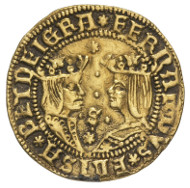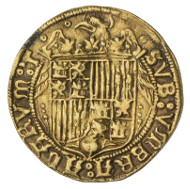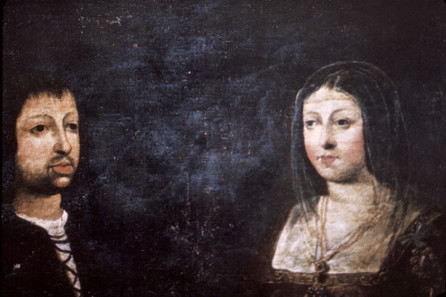courtesy of the MoneyMuseum, Zurich
translated by Teresa Teklic
Why was the human head the motif on coins for centuries, no, for millennia? And why did that change in the last 200 years? Ursula Kampmann is looking for answers to these questions in her book “Menschengesichter” (“Human faces”), from which the texts in this series are taken.
Spain. Ferdinand and Isabella (1479-1504). Dobla Excelente, Sevilla. Crowned busts of Ferdinand (to the right) and Isabella (to the left). Rv. Coat of arms of Castile and Leon, eagle with wings spread in the background. © MoneyMuseum, Zurich.
There are few women in the Early Modern Period whose name is still equally well known today as their husbands’ name. There are few women from that time whose portrait can be found next to their husbands’ portrait on coins. Very few. One of them is Isabella I, Queen of Castile.
At age 17, a civil war in the country made Isabella heiress to the throne. Her brother Henry IV of Castile was pressured by oppositional aristocrats into disinheriting his own children in favour of Isabella. All of a sudden, Isabella became a highly desirable match. Among her suitors were the heir to the Portuguese throne and the brother of the French king – but Isabella had her own plans.
Wedding image of Ferdinand and Isabella, 1469. Source: Wikicommons.
When the King of Aragón offered his son and heir Ferdinand, Isabella accepted under one condition: Ferdinand was obliged to make all decisions concerning Castile together with her. Every decree had to bear the signatures of both rulers. The King of Aragón agreed to her terms and sealed the marital deal. However, Henry IV was still in power and, in theory, he could force Isabella to marry his favoured candidate. The young woman had to act fast.
Isabella left the court under the pretence of visiting her mother. On the way, she asked Ferdinand to join her as quickly as possible to consummate their marriage. Ferdinand was hesitant. He was the only heir to a 69-year-old, blind father. Was it really worth the risk? Yes, to become the ruler of Castile he was willing to take that risk. And so the prince took off to Castile, disguised as a stable boy and escorted by only six guards. Every night, the future Catholic majesty groomed the horses, or so the story goes. Ferdinand arrived in Valladolid, where his bride was awaiting him. On October 14, 1469, the two met for the first time. Isabella did not immediately recognise Ferdinand: “That’s him,” someone had to tell her. The wedding was held five days later. But one obstacle remained: Ferdinand and Isabella were related and the papal dispensation not yet granted. Without a moment’s hesitation, a bishop read out a fake bull which permitted the marriage. Now, Isabella of Castile and Ferdinand of Aragón were officially wed. But the victory was still a long way ahead. It would take another five long and hard years until Isabella could take the throne and begin her reign, which would bring peace to her country and pave the way so Spain could become Europe’s most powerful nation.
In the next episode, we will stay in the family and take a closer look at the coat of arms which Isabella’s grandson, Charles V, had minted on his coins.
You can find all episodes in the series here.
A German edition of the book “Menschengesichter” is available in print and as ebook on the site of the Conzett Verlag.








